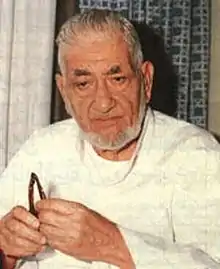Umar al-Tilmisani
'Umar al-Tilmisani (Arabic: عمر التلمساني, IPA: [ˈʕomɑɾˤ et.telmeˈsæːni]; most often transliterated as Omar el Telmesany or Telmesani ) (4 November 1904 – 22 May 1986) was the third General Guide (Murshid al-'Am) of the Egyptian Muslim Brotherhood. He headed the Egyptian Islamist organization from 1972 until 1986. Al-Tilmisani (his name is a variation on Tlemceni, reflecting his family origin in the Western Algerian city of that name) headed the Muslim Brotherhood during a period of cooperation and, some observers suggest, cooptation by the Egyptian state. While the Brothers were not precisely legal during Tilmisani's term, they were tolerated and encouraged by President Anwar al-Sadat as a bulwark against both leftist opponents and more extremist Islamists.
Umar al-Tilmisani عمر التلمساني | |
|---|---|
 | |
| 3rd General Guide of the Egyptian Muslim Brotherhood | |
| In office 1972–1986 | |
| Preceded by | Hassan al-Hudaybi |
| Succeeded by | Muhammad Hamid Abu al-Nasr |
| Personal details | |
| Born | 4 November 1904 Cairo, Egypt |
| Died | 22 May 1986 (aged 81) Cairo, Egypt |
| Nationality | Egyptian |
Biography
Al-Tilmisani was born in the Darb al-Ahmar district of Cairo in 1904. A lawyer, al-Tilmisani joined the Brothers in 1933, and was inducted into the organization by its founding General Guide, Hassan al-Banna.
Al-Tilmisani was from a family of prominent landowners, which owned 300 feddans (acres) and seven houses. His deputy, and a later successor as General Guide, Mustafa Mashhur, was also from a family of wealthy landowners. Their prominence and social status led historian Robert Springborg to conclude at the end of the 1980s that, "It can reasonably be claimed that those currently in control of the Muslim Brothers are of the Islamic infitah bourgeoisie who 'bought' the organization with resources acquired through collaboration with the Sadat regime".[1]
Despite heading the group during this period of cooperation with the state, al-Tilmisani was imprisoned three times, once in 1954, as an activist during the difficult Nasser years, and twice while at the head of the group, during Sadat's mass roundup of opponents in 1981, and again under Hosni Mubarak in 1984.
References
- Springborg, Robert (1989). Mubarak's Egypt: Fragmentation of the Political Order. Boulder: Westview Press. p. 236. ISBN 0-8133-7643-2.
| Religious titles | ||
|---|---|---|
| Preceded by Hassan al-Hudaybi |
General Guide of the Muslim Brotherhood 1972–1986 |
Succeeded by Muhammad Hamid Abu al-Nasr |